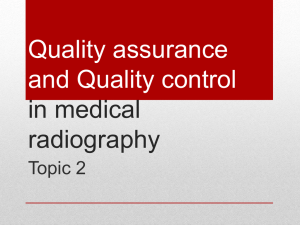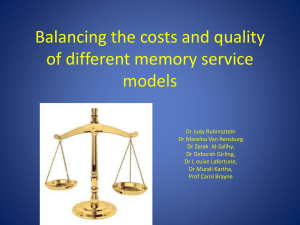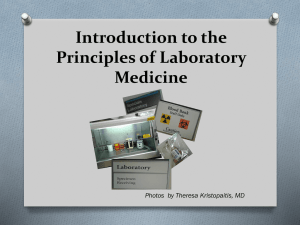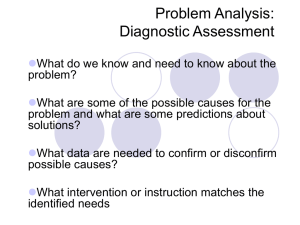Quality control in diagnostic radiology – its historical development
advertisement
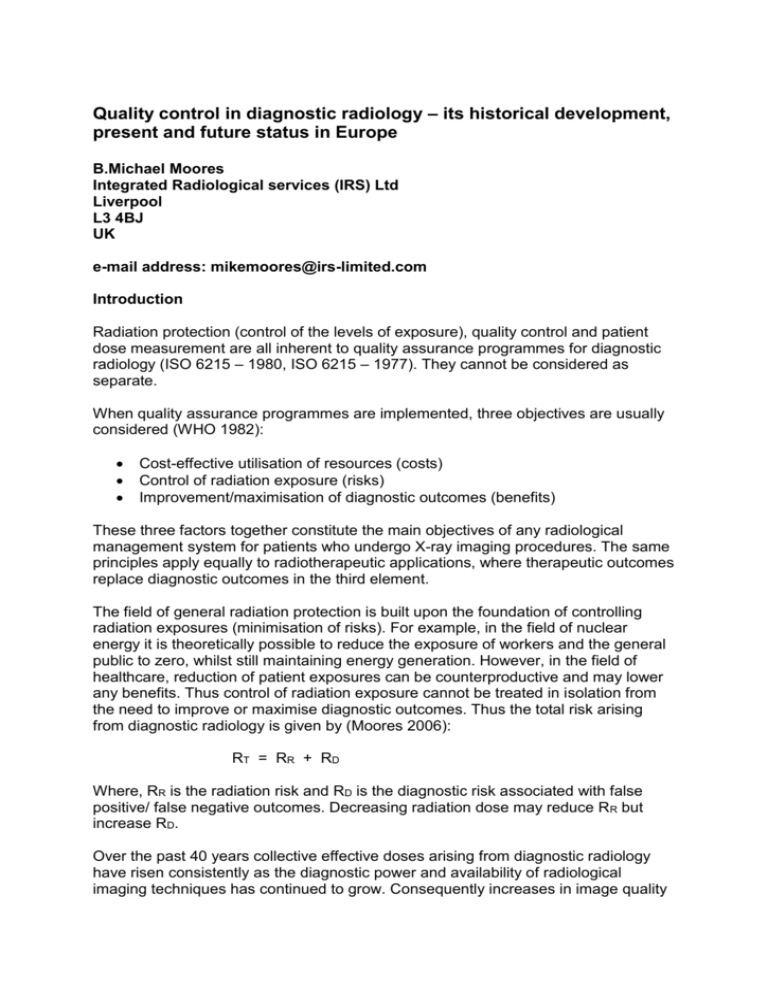
Quality control in diagnostic radiology – its historical development, present and future status in Europe B.Michael Moores Integrated Radiological services (IRS) Ltd Liverpool L3 4BJ UK e-mail address: mikemoores@irs-limited.com Introduction Radiation protection (control of the levels of exposure), quality control and patient dose measurement are all inherent to quality assurance programmes for diagnostic radiology (ISO 6215 – 1980, ISO 6215 – 1977). They cannot be considered as separate. When quality assurance programmes are implemented, three objectives are usually considered (WHO 1982): Cost-effective utilisation of resources (costs) Control of radiation exposure (risks) Improvement/maximisation of diagnostic outcomes (benefits) These three factors together constitute the main objectives of any radiological management system for patients who undergo X-ray imaging procedures. The same principles apply equally to radiotherapeutic applications, where therapeutic outcomes replace diagnostic outcomes in the third element. The field of general radiation protection is built upon the foundation of controlling radiation exposures (minimisation of risks). For example, in the field of nuclear energy it is theoretically possible to reduce the exposure of workers and the general public to zero, whilst still maintaining energy generation. However, in the field of healthcare, reduction of patient exposures can be counterproductive and may lower any benefits. Thus control of radiation exposure cannot be treated in isolation from the need to improve or maximise diagnostic outcomes. Thus the total risk arising from diagnostic radiology is given by (Moores 2006): RT = RR + RD Where, RR is the radiation risk and RD is the diagnostic risk associated with false positive/ false negative outcomes. Decreasing radiation dose may reduce R R but increase RD. Over the past 40 years collective effective doses arising from diagnostic radiology have risen consistently as the diagnostic power and availability of radiological imaging techniques has continued to grow. Consequently increases in image quality (diagnostic power) rather than a reduction in patient dose mainly underpins modern practice. Consequently CT examinations, now considered to represent the “gold standard” for diagnostic outcomes, constitute 5% of worldwide radiological examinations yet contribute one third of the collective dose associated with medical exposure. In the US studies quote CT as comprising 11% of examinations while delivering two thirds of the total radiation dose. Any attempt to provide a historical overview of quality assurance including quality control, patient dose and radiation protection in diagnostic radiology should take cognisance of the technological and philosophical changes that have driven medical practices. Thus an overview may be considered in three parts: The development of test procedures and standardisation of practices (1950 – 1980) Harmonisation of initiatives of initiatives and the creation of a European dimension in quality assurance practices (1980 – 2005) The role and function of quality assurance in a changing and evolving technological environment – current status and future trends The development of test procedures and standardisation of practices The roots of quality assurance in diagnostic radiology, including quality control, radiation protection and patient dose, may be traced back to the 1950s. At this time there was just three X-ray imaging modalities; radiography, fluoroscopy and conventional tomography. A growing interest was developing throughout Europe and North America in developing a more scientific framework for diagnostic radiology including an improved understanding of its limitations. There was also a growing awareness of the need to quantify and assess the levels of radiation employed diagnostically. Up until this time most scientific effort in the medical uses of X-rays was being expended in the field of radiotherapy (Moores 2000). These early initiatives were pursued by a relatively small group of radiologists, physicists and engineers working in industry and healthcare throughout Europe and North America. Concepts such as noise, resolution and visual performance that had been developed elsewhere for quantifying/assessing system performance, were being applied to the radiologic image (Sturm and Morgan 1949, Schade 1951, Mertz 1950, Burger 1950). Also technical developments in image intensification for medical applications were receiving increased attention (Hay 1958, 1960). As well as the scientific and technical aspects of X-ray image production, interest was growing in the levels of radiation employed in diagnostic radiology and dosimetric measurement methods (Osborn and Burrows 1958, Stuart and Osborn 1959). During the late 1950s in the UK the Adrian Committee organised a survey of the extent of medical and dental radiology in Great Britain in order to assess the levels of radiation dose employed and make recommendations for its reduction. The findings of the committee were published in three parts between 1959 and 1966 (Adrian Committee 1959, 1960, 1966). The reports included recommendations for reducing the genetically significant doses from diagnostic radiological practices since genetic risks were considered, at this time to be, the major hazard. The early initiatives led to three meeting held in Washington (Janower 1963), Chicago (Moseley and Rust 1964) and Chicago (Moseley and Rust 1965). These meetings brought together experts, from both Europe and North America and included radiologists, engineers and scientists and involved a transfer of information between the manufacturers and users of X-ray equipment. Also, the meetings were not only concerned with the technical basis of X-ray imaging methods but also methods for reducing patient dose by instrumentation and technological developments. However, over the intervening 40-year period, technological developments have led to the completely opposite outcome based upon a desire and capability for improved information. Whilst these more fundamental initiatives were underway, interested individuals, who were working within the healthcare sector, continued to develop methods for assessing the performance of radiological systems and the application of imaging sciences to diagnostic radiology. Research, including methods for making measurements on X-ray beams, radiological imaging systems, image quality and perception, were all pursued. In 1974 the Hospital Physicist’s Association (HPA) in the UK published in a single document what had previously been four individual reports dealing with the physical aspects of the important imaging components (HPA 1974). This has subsequently revised on a number of occasions. Particular attention was paid to those aspects of performance that could be quantified. The transfer of basic research on systems performance and methods of measurement, into routine application within the clinical domain had now begun. However, test methods were extremely varied and in most instances test equipment was manufactured locally to personal design so that results could not easily be compared. The momentum was maintained throughout the 1970s as individuals continued to develop, implement and refine methods for measuring X-ray system performance. Results of this effort in the UK were presented at two meetings, organised by the Diagnostic Radiology Topic Group of the HPA, which dealt with quality assurance in diagnostic radiology (HPA 1977, 1979). The first of these meetings established the need for standard protocols, methods and procedures, for assessing the performance of radiological systems. Preliminary drafts were prepared by the Topic Group and in 1980; the first protocol dealing with X-ray tubes and generators was published (HPA 1980). This was followed almost immediately by protocols dealing with image intensifier/TV systems, screen-films and automatic processors, CT scanners and conventional tomographic units. As well as standardising methods and practices these documents constituted a powerful demonstration of the role and function of quality assurance in diagnostic radiology. Once standard methods had been developed, then the justification for the role and function of radiographers and physicists in this area could be more easily demonstrated. Indeed these documents led the way in terms of the standardised application of quality assurance and control methods in healthcare. They also helped to spawn an extensive commercial development of instrumentation for quality control measurements in diagnostic radiology that continues to the present. However, whilst these activities were underway, there was continued technological development and ongoing basic research in diagnostic imaging methods being pursued including rare earth intensifying screens, CsI image intensifiers, digital (subtraction) fluoroscopy, mammography, xeroradiography and ionography. There was a need for a dynamic scientific process within quality assurance in diagnostic radiology based upon the application of research and development methods. Also, up until this point the routine application of patient dose measurements was somewhat peripheral to the assessments of equipment performance. Harmonisation of initiatives and creation of a European dimension The beginning of a truly European dimension to quality assurance in diagnostic radiology can be traced to a meeting held in Munich-Neuherberg in April 1981 organised by the Commission of European Communities. The purpose of this meeting was to discuss with a group of European experts the possibility of reducing patient doses from medical X-ray diagnosis (Drexler et al 1981). This meeting highlighted the need for a separate EU Directive on radiological protection of the patient and the need for an EC research effort to reduce patient exposure. Following this preliminary meeting a Council Directive concerned with protection of the patient was issued in 1984 (84/466/EURATOM). As part of the underpinning initiatives to support the Directive experts from research, industry and public health services involved in medicine came together to participate in a seminar on “Criteria and methods for quality assurance in medical X-ray diagnosis” held in Udine, Italy (Brit J. Radiol. 1985). This meeting coincided with the commencement of an extended research programme in the field of radiation protection in diagnostic radiology. Prior to this contractors had been representatives from Government Laboratories and major University Hospitals. However, much of the expertise in this area lay with individuals working in routine medical practice and these were now included in the programme. During the period of the research programme (1985-89) and ancillary to it a Working Group was established in order to develop a set of Quality Criteria for Radiographic Images of adult patients. This initiative was aimed at developing advice and guidance for Member states to aid fulfilment of the 1984 Directive. A trial of a preliminary document was implemented during 1987 and reported as an Official Publication of the Commission (EC 1990). For the first time the Quality Criteria brought together the three elements of a comprehensive quality assurance programme for diagnostic radiology, namely; radiographic/technical requirements for an examination, the quality of the resulting image and the patient dose expressed in terms of entrance surface dose. In order to strengthen and harmonise work on quality assurance throughout Europe a meeting was held in Brussels concerned with the technical and physical parameters for quality assurance (BIR 1989a). This meeting was closely followed by one on optimisation of image quality and patient exposure in diagnostic radiology (BIR 1989b). These meetings provided a forum for the presentation of research outcomes from the EC Radiation Protection Research Programme and helped to create a European dimension for work in this field. Important outcomes from this work were the continuous development of quality control test methods and procedures as well as the associated instrumentation. Whereas up until the 1970s test equipment was locally produced throughout the 1980s a wide range of equipment was commercially available. Quality assurance and associated quality control procedures had now become an established and commercial activity within diagnostic radiology. A major operational change was implemented within the framework of the 1990-94 European research programme. Co-ordinated research groups were established in order to tackle specific problems in quality assurance. Whilst the main research programme was underway a number of important activities were also being pursued. This included a second trial of the Quality criteria Document in 1991 and a report published (EC 1997) Based upon findings of the study an update of the document quality criteria for adult patients was produced (EC 1996a) and this was followed by Quality Criteria for paediatric patients (EC 1996b) and criteria for CT were under development (EC 1999). In this period a protocol for patient dose measurement in mammography was produced (EC 1996c) Three workshops were organised during this period in conjunction with the Commission and they provided a forum for dissemination of the results of the research programmes underway throughout Europe. They were concerned with: Dosimetry in diagnostic radiology (Rad Prot Dosim 1992) Test phantoms and optimisation in diagnostic radiology and nuclear medicine (Rap Prot Dosim 1993) Quality control and radiation protection of the patient in diagnostic radiology and nuclear medicine (Rad Prot Dosim 1995) These meetings were held within the space of 30 months and involved over 240 scientific papers presented by participants from all over Europe. The momentum gained in this period was carried forward in to the 4 th and 5th Framework Radiation Protection Research Programmes covering the periods 199498 and 1998-2002 through both co-ordinated research and concerted action projects. These were in the fields of optimisation of radiological information and patient protection and attempts to keep abreast of the ongoing technological developments in the field of diagnostic radiology. In particular new methods for assessing image quality, IT applications in the field of radiation protection, developments in interventional radiology/cardiology and CT were all being addressed. Outcomes from this work formed the basis of European workshops and published proceedings (Rad Prot Dos 2000, 2005a, 2005b) Current status and future needs There is no doubt that quality assurance including quality control, radiation protection and patient dose measurement in diagnostic radiology has evolved significantly both philosophically and practically over the past 50 years. It is now an accepted part of routine radiological practice and has helped to introduce a more scientific approach to this activity. It has led the way in terms of the application of quality assurance in healthcare. Also, given the increasing importance of imaging in therapeutic applications it is influencing scientific practice outside diagnostic radiology. Research based activities in the field of quality assurance continue to underpin the ongoing development of the field. Thus new test methods are continuously being required to evaluate and assess new forms of X-ray imaging particularly in the field of 3 dimensional imaging methods. This includes new techniques and methods for assessing patient dose. The impact of IT on the diagnostic imaging process, through the introduction of new detectors and PACS systems continues to open up new possibilities for automated quality assurance processes including improved data analysis and centralised management systems. The use of clinical images in routine quality control methods is also becoming a reality. These developments can have a major impact on the optimisation of radiological practices throughout Europe. The philosophical shift in emphasis away from patient dose reduction towards higher levels of information from an examination that has occurred over the past several years, based upon volume CT scanning methods will need to be addressed. New forms of 3 dimensional imaging techniques offer the potential for lowering doses whilst improving information content. Similarly computer aided diagnostic (CAD) techniques provide the basis for quantifying and comparing diagnostic outcomes that may lead to greater consistency and improved performance. These are important optimisation considerations. Medical physics can continue to play a significant role in introducing more quantitative and scientific methods into the field of diagnostic radiology. However, to have maximum impact the training of young medical physicists in the field of diagnostic radiology throughout Europe will need to be reviewed and updated. In such a dynamic and changing environment research and development should play a more important role in training programmes if skill and knowledge levels are to be maintained at the required levels. The increasing role of medical imaging procedures in both diagnosis and therapy requires a supply of suitably trained scientific staff if the ongoing technological changes in healthcare are to be adequately supported as well as act as a basis for ongoing innovation and new creative applications (Moores 2000). References Adrian Committee. Radiological hazards to patients. Interim report. Her Majesty’s Stationery Office (HMSO), London, 1959. Ibid. Second report. HMSO, London, 1960 Ibid. Final report. HMSO, London, 1969. BIR Report 18. Technical and physical parameters for quality assurance in medical diagnostic radiology. British Institute of radiology, London 1989a BIR Report 20. Optimization of image quality and patient exposure in diagnostic radiology. British Institute of radiology, London. !989b Brit J Radiol. Criteria and methods for quality assurance in medical X-ray diagnosis. Supplement 18, 1985. Burger G.C.E. Phantom tests with X-rays. Philips Technical Rev. 11, 291, 1950. Drexler G., Eriskat H. and Schibilla H. Patient exposure to radiation in medical X-ray diagnosis-possibilities for dose reduction. EUR 7438, Luxembourg 1981. EC. CEC Quality critieria for diagnostic radiographic images and patient exposure trial. Report EUR 12952 EN Luxembourg (1990). EC Dosimetry in diagnostic radiology. EUR 14180 EN. Radiation Protection Dosimetry. 43 Nos 1-4, (1992) EC. Test phantoms and optimisation in diagnostic radiology and nuclear medicine. EUR 14767 EN. Radiation Protection Dosimetry. 49, Nos 1-3, (1993) EC. Quality control and radiation protection of the patient in diagnostic radiology and nuclear medicine. EUR 15257 EN. Radiation Protection Dosimetry. 57, Nos 1-4, (1995). EC European Guidelines on Quality Criteria for Diagnostic Radiographic Images. Report EUR 16260 EN Luxemburg (1996a). EC European Guidelines on Quality Criteria for Diagnostic Radiographic Images in Paediatrics. Report EUR 16261 EN Luxembourg (1996b) EC European Protocol on Dosimetry in Mammography. Report EUR 16263 EN Luxembourg (1996c) EC The 1991 CEC trial on quality criteria for diagnostic radiographic images: detailed results and findings. Report EUR 16635 EN, Luxembourg (1997) EC European Guidelines on Quality Criteria for Computed Tomography. Report EUR 16262 EN Luxembourg (1999) European Council Directive 84/466/EURATOM. Official Journal of the European Communities, Luxembourg, L265 (5.10.1984). Hay G. A. X-ray image intensification using optical television methods. Advances in electronics and electron physics. New York, Academic Press, 363, 1960. Hay G.A. Quantitative aspects of television techniques in diagnostic radiology. Brit J. Radiol. 31, 611, 1958. HPA. The Physics of Radiodiagnosis. (First edition) SRS-6 (Hospital Physicists’ Association, London) 1974. HPA. Quality control in diagnostic radiology. CRS 26, Hospital Physicists’ Association, London 1977. HPA. Quality assurance measurements in diagnostic radiology. CRS-29, Hospital Physicists’ Association, London 1979. HPA. Measurement of the performance characteristics of diagnostic X-ray systems used in medicine. Part 1 – X-ray tubes and generators. (Topic Group Report 32) Hospital Physicists’ Association, London, 1980. International Organization for Standardisation. Nuclear power plants – quality assurance, Geneva, 1980 (International Standards ISO 6215 – 1980). International Organization for Standardisation. Statistics – vocabulary and symbols. Geneva, 1977 (International Standards ISO 3534 – 1977). Janower M.L. Technological needs for reduction of patient dosage from diagnostic radiology. Charles C. Thomas, Springfield Illinois, 1963. Mertz P. Perception of television random noise. Journ. S.M.P.T.E., 54, 8, 1950. Moores B.M. Radiation safety management in healthcare – the application of Quality Function Deployment. Radiography, 12, 291-304, 2006 Moores B.M. Technology-driven science in healthcare – is Europe falling behind. In the Proceedings of the ERPET course on Establishing Reference Levels for Diagnostic Radiology. Passau, Germany, September 1999. EC Doc RTD/0034/20, 2000. Moseley R.D. and Rust J.H. The reduction of patient dose by diagnostic radiologic instrumentation. Charles C. Thomas, Springfield, Illinois 1964. Moseley R.D. and Rust J.H. Diagnostic radiologic instrumentation. Charles C. Thomas, Springfield, Illinois, 1965. Osborn S.B. and Burrows R.G. An ionisation chamber for diagnostic X-radiation. Phys Med Biol, 3, 37, 1958. Rad Prot Dosim. Dosimetry in diagnostic radiology. 43, Nos 1-4, (1992). Rad Prot dosim.Test phantoms and optimisation in diagnostic radiology and nuclear medicine. 49, Nos 1/3, (1993). Rad Prot Dosim. Quality control and radiation protection of the patient in diagnostic radiology and nuclear medicine. 57, Nos 1-4, (1995) Rad Prot Dos. Medical X-ray imaging: potential impact of the new directive. Radiation Protection Dosimetry. 90, Nos 1-3, (2000) Rad Prot Dos. Optimisation strategies in medical X-ray imaging. Radiation Protection Dosimetry. 114, Nos 1-3, (2005a) Rad Prot Dos. Optimisation of dose and performance in interventional and digital imaging. Radiation Protection Dosimetry, 117, nos 1-3, (2005b) Schade O. Image structure and transfer characteristics. Journ. S.M.P.T.E., 56, 137, 1951. Stuart S. and Osborn S.B. A wide-range direct reading X-ray dosemeter. Phys Med Biol, 3, 255, 1959. Sturm R.E. and Morgan R.H. Screen intensification systems and their limitations. Am. J. Roentgen. 62, 617, 1949. WHO. Quality assurance in diagnostic radiology. World Health Organisation, Geneva, Switzerland. 1982.


